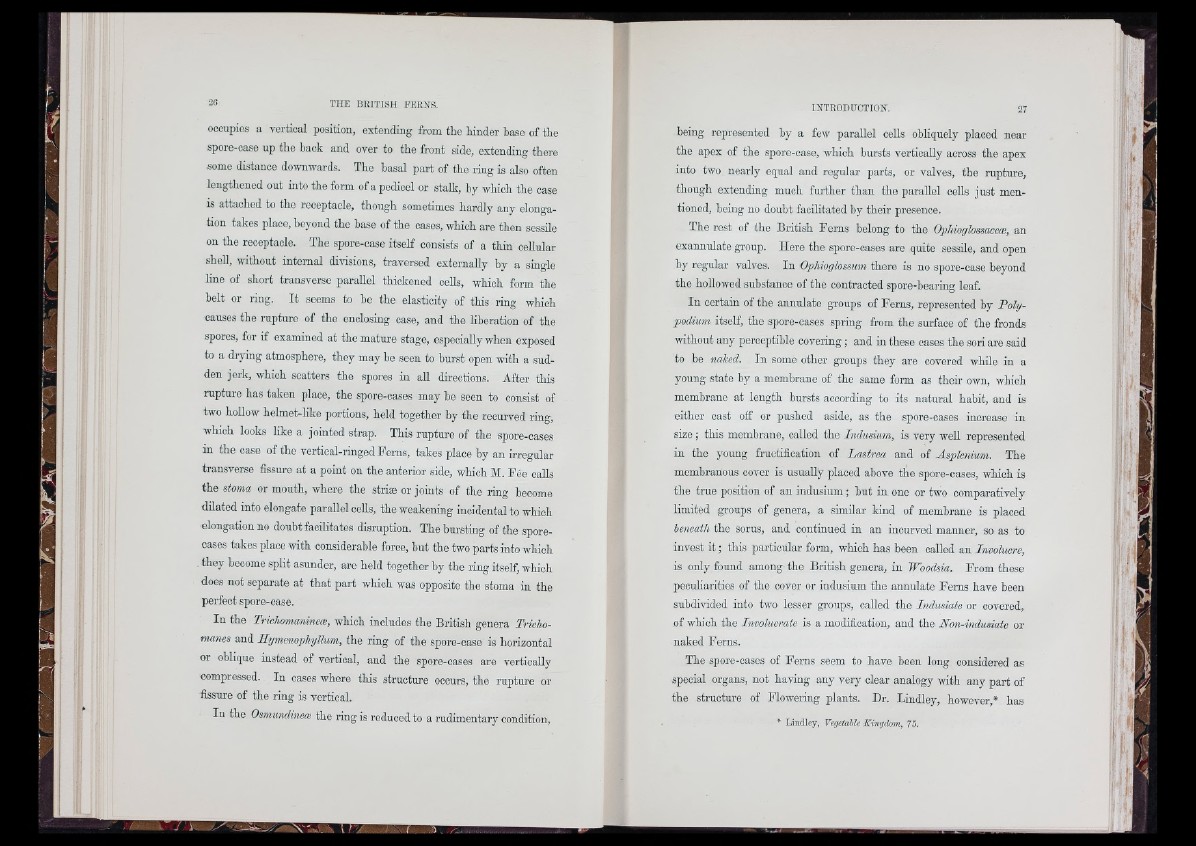
occupies a vertical position, extending from the hinder base of the
spore-case up the back and over to the front side, extending there
some distance downwards. The basal part of the ring is also often
lengthened out into the form of a pedicel or stall;:, by which the case
is attached to the receptacle, though sometimes hardly any elongation
takes place, beyond the base of the cases, which are then sessile
on the receptacle. The spore-oase itself consists of a thin cellular
shell, without internal divisions, traversed externally hy a single
line of short transverso parallel thickened cells, which form the
belt or ring. I t seems to be tho elasticity of this ring which
causes the rupture of tho enclosing case, and the liberation of the
spores, for if examined at the mature stage, especially when exposed
to a drying atmosphere, they may be seen to burst open with a sudden
jerk, which scatters the spores in all directions. After this
ruptm-e has taken place, the spore-oases may be seen to consist of
two hollow helmet-like portions, held together by the recurved ring,
which looks like a jointed strap. This rupture of the spore-oases
m the case of the vertical-ringed Ferns, takes place hy an irregular
transverse fissure at a point on the anterior side, which M. Fée calls
the stoma or mouth, where the strise or joints of the ring become
dilated into elongate parallel cells, the weakening incidental to which
elongation no doubt facilitates disruption. The bursting of the spore-
cases takes place with considerable force, but the two parts into which
they become split asunder, are held together by the ring itself, which
does not separate at th a t part which was opposite the stoma in the
perfect spore-case.
In the TrichomaninecB, which includes the British genera Trichomanes
and HymenophyUum, the ring of the spore-case is horizontal
or oblique instead of vertical, and the spore-oases are vertically
compressed. In oases where this structure occurs, the rupture or
fissure of the ring is vertical.
In the Osmimdineai the ring is reduced to a rudimentary condition.
being represented hy a few parallel cells obliquely placed near
the apex of the spore-case, which bursts vertically across the apex
into two nearly equal and regular parts, or valves, the rupture,
though extending much further than the parallel cells just mentioned,
being no doubt facilitated by their presence.
The rest of the British Ferns belong to the Ophioglossaeece, an
exannulate group. Here the spore-oases are quite sessile, and open
by regular valves. In Ophioglossum there is no spore-case beyond
the hollowed substance of the contracted spore-bearing leaf.
In certain of the annulate groups of Ferns, represented hy Polypodium
itself, the spore-cases spring from the surface of the fronds
without any perceptible covering; and in these cases the sori are said
to be nahed. In some other groups they are covered while in a
young state by a membrane of tho same form as their own, which
membrane at length bursts according to its natural habit, and is
either oast off or pushed aside, as the spore-cases increase in
size; this membrane, called the Indusium, is very well represented
in the young fructification of Lastrea and of Asplenium. The
membranous cover is usually placed above the spore-cases, which is
the true position of au indusium; hut in one or two comparatively
limited groups of genera, a similar kind of membrane is placed
beneath the sorus, and continued in an incurved manner, so as to
invest i t ; this particular form, which has been called an Involucre,
is only found among the British genera, in Woodsia. From these
peculiarities of the cover or indusium the annulate Ferns have been
subdivided into two lesser groups, called the Indusiate or covered,
of which the Involúcrate is a modification, and the Non-indiisiate or
naked Ferns.
The spore-cases of Ferns seem to have been long considered as
special organs, not having any very clear analogy with any part of
the structure of Flowering plants. Dr. Bindley, however,* has
^ Lindley, Vegetable Kingdom, 75.